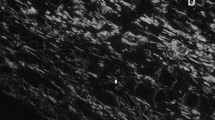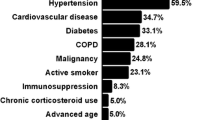Abstract
Purpose
Angiotensin II (AT II) receptor blockers have previously shown to reduce inflammatory response in many settings. We aimed to assess the effects of ATII receptor blocker (Losartan) on mesh integration after abdominal wall repair in a rat model.
Methods
A total of 16 Wistar-Kyoto (WKY) and 16 previously hypertensive (SHRSP) rats were isolated. An acute ventral hernia followed by a bridged repair with heavyweight polypropylene mesh was performed. Subjects received either normal saline (WKY-C n = 8 and SHRPS-C n = 8) or 40 mg/kg losartan (WKY-L n = 8) and SHRPS-L n = 8) in the postoperative period. Blood pressure was recorded preoperatively and weekly after surgery. Necropsy with en-bloc resection of the abdominal wall was performed at postoperative day 30. Macroscopic and microscopic evaluations of the specimens were conducted. H&E and Masson’s trichrome were used for histologic evaluation.
Results
Both groups receiving Losartan showed a significant reduction of blood pressure after surgery (WKY-L: 130/85 vs 116/81 mmHg, SHRPS-L: 176/137 vs 122/101 mmHg, p < 0.01). A significant reduction in mesh incorporation and adherence scores were also observed on macroscopic analysis in Losartan groups (p < 0.01 and p = 0.02, respectively). Microscopically, higher immature fibroplasia was observed after Losartan, with a significant reduction in scar plate formation and inflammatory response on the prosthetic surface (p = 0.04 and p = 0.02, respectively).
Conclusion
Losartan modifies the interaction between the host tissue and the prosthesis. An impairment in mesh integration and immature fibroplasia in both normotensive and hypertensive rats detected in our model warrants further research.




Similar content being viewed by others
References
Rutkow IM (2003) Demographic and socioeconomic aspects of hernia repair in the United States in 2003. Surg Clin North Am. https://doi.org/10.1016/S0039-6109(03)00132-4
Poulose BK, Shelton J, Phillips S, Moore D, Nealon W, Penson D, Beck W, Holzman MD (2012) Epidemiology and cost of ventral hernia repair: making the case for hernia research. Hernia 16(2):179–183. https://doi.org/10.1007/s10029-011-0879-9
HerniaSurge Group (2018) International guidelines for groin hernia management. Hernia 22(1):1–165. https://doi.org/10.1007/s10029-017-1668-x
Henriksen NA, Montgomery A, Kaufmann R, Berrevoet F, East B, Fischer J, Hope W, Klassen D, Lorenz R, Renard Y, Garcia Urena MA, Simons MP (2020) European and Americas Hernia Societies (EHS and AHS). Guidelines for treatment of umbilical and epigastric hernias from the European Hernia Society and Americas Hernia Society. Br J Surg 107(3):171–190. https://doi.org/10.1002/bjs.11489
Luijendijk RW, Hop WC, van den Tol MP, de Lange DC, Braaksma MM, IJzermans JN, Boelhouwer RU, de Vries BC, Salu MK, Wereldsma JC, Bruijninckx CM, Jeekel J (2000) A comparison of suture repair with mesh repair for incisional hernia. N Engl J Med 10;343(6):392–8. https://doi.org/10.1056/NEJM200008103430603
Sadava EE, Peña ME, Schlottmann F (2019) Should we routinely close the fascial defect in laparoscopic ventral and incisional hernia repair? J Laparoendosc Adv Surg Tech A 29(6):856–859. https://doi.org/10.1089/lap.2019.0088
Gonzalez R, Fugate K, McClusky D 3rd, Ritter EM, Lederman A, Dillehay D, Smith CD, Ramshaw BJ (2005) Relationship between tissue ingrowth and mesh contraction. World J Surg 29(8):1038–1043. https://doi.org/10.1007/s00268-005-7786-0
Petro CC, Nahabet EH, Criss CN, Orenstein SB, Von Recum HA, Novitsky YW, Rosen MJ (2015) Central failures of lightweight monofilament polyester mesh causing hernia recurrence: a cautionary note. Hernia 19(1):155–159. https://doi.org/10.1007/s10029-014-1237-5
Parker MJ, Kim RC, Barrio M, Socas J, Reed LR, Nakeeb A, House MG, Ceppa EP (2020) A novel biosynthetic scaffold mesh reinforcement affords the lowest hernia recurrence in the highest-risk patients. Surg Endosc. https://doi.org/10.1007/s00464-020-08009-1
Artsen AM, Rytel M, Liang R, King GE, Meyn L, Abramowitch SD, Moalli PA (2019) Mesh induced fibrosis: the protective role of T regulatory cells. Acta Biomater 96:203–210. https://doi.org/10.1016/j.actbio.2019.07.031
Sadava EE, Krpata DM, Gao Y, Rosen MJ, Novitsky YW (2014) Wound healing process and mediators: Implications for modulations for hernia repair and mesh integration. J Biomed Mater Res A 102(1):295–302. https://doi.org/10.1002/jbm.a.34676
Benigni A, Cassis P, Remuzzi G (2010) Angiotensin II revisited: new roles in inflammation, immunology and aging. EMBO Mol Med 2(7):247–257. https://doi.org/10.1002/emmm.201000080
Suzuki Y, Ruiz-Ortega M, Egido J (2000) Angiotensin II: A double-edged sword in inflammation. J Nephrol 13(Suppl 3):S101–S110
Ruiz-Ortega M, Lorenzo O, Egido J (2000) Angiotensin III increases MCP-1 and activates NF-B and AP-1 in cultured mesangial and mononuclear cells. Kidney Int 57:2285–2298. https://doi.org/10.1046/j.1523-1755.2000.00089.x
Wu L, Chen K, Xiao J, Xin J, Zhang L, Li X, Li L, Si J, Wang L, Ma K (2020) Angiotensin II induces RAW264.7 macrophage polarization to the M1-type through the connexin 43/NF-κB pathway. Mol Med Rep 21(5):2103–2112. https://doi.org/10.3892/mmr.2020.11023
Mills KT, Bundy JD, Kelly TN, Reed JE, Kearney PM, Reynolds K, Chen J, He J (2016) Global disparities of hypertension prevalence and control: a systematic analysis of population-based studies from 90 Countries. Circulation 134(6):441–450. https://doi.org/10.1161/CIRCULATIONAHA.115.018912
Whelton PK, Carey RM, Aronow WS, Casey DE Jr, Collins KJ, Dennison Himmelfarb C, DePalma SM, Gidding S, Jamerson KA, Jones DW, MacLaughlin EJ, Muntner P, Ovbiagele B, Smith SC Jr, Spencer CC, Stafford RS, Taler SJ, Thomas RJ, Williams KA Sr, Williamson JD, Wright JT Jr (2018) ACC/AHA/AAPA/ABC/ACPM/AGS/APhA/ASH/ASPC/NMA/PCNA Guideline for the prevention, detection, evaluation, and management of high blood pressure in adults: A Report of the American College of Cardiology/American Heart Association Task Force on Clinical Practice Guidelines. Hypertension 71(6):e13–e115. https://doi.org/10.1161/HYP.0000000000000065
Oztürk CN, Tezel E, Yalçın O (2011) Evaluation of the effects of losartan on a random pattern skin flap model in rats. Ulus Travma Acil Cerrahi Derg 17(2):97–102
Biondo-Simões Mde L, Zazula AD, Gomes AB, Poncio C, Torres LF, Borsato KS (2006) Influence of arterial hypertension treated with losartan on skin healing in rats. Acta Cir Bras 21(3):144–150. https://doi.org/10.1590/s0102-86502006000300005
Criss CN, Gao Y, De Silva G, Yang J, Anderson JM, Novitsky YW, Soltanian H, Rosen MJ (2014) The effects of Losartan on abdominal wall fascial healing. Hernia 19(4):645–650. https://doi.org/10.1007/s10029-014-1241-9
Feng M, Whitesall S, Zhang Y, Beibel M, D’Alecy L, DiPetrillo K (2008) Validation of volume-pressure recording tail-cuff blood pressure measurements. Am J Hypertens 21(12):1288–1291. https://doi.org/10.1038/ajh.2008.301
Jansen JA, Dhert WJ, van der Waerden JP, von Recum AF (1994) Semi-quantitative and qualitative histologic analysis method for the evaluation of implant biocompatibility. J Invest Surg 7(2):123–134. https://doi.org/10.3109/08941939409015356
Harrell AG, Novitsky YW, Cristiano JA, Gersin KS, Norton HJ, Kercher KW, Heniford BT (2007) Prospective histologic evaluation of intra-abdominal prosthetics four months after implantation in a rabbit model. Surg Endosc 21(7):1170–1174. https://doi.org/10.1007/s00464-006-9147-y
Kearney PM, Whelton M, Reynolds K, Muntner P, Whelton PK, He J (2005) Global burden of hypertension: analysis of worldwide data. Lancet 365(9455):217–223. https://doi.org/10.1016/S0140-6736(05)17741-1
Shimizu A, Takei T, Uchida K, Tsuchiya K, Nitta K (2008) Low-dose losartan therapy reduces proteinuria in normotensive patients with immunoglobulin A nephropathy. Hypertens Res 31(9):1711–1717. https://doi.org/10.1291/hypres.31.1711
Koprdova R, Cebova M, Kristek F (2009) Long-term effect of losartan administration on blood pressure, heart and structure of coronary artery of young spontaneously hypertensive rats. Physiol Res 58(3):327–335. https://doi.org/10.33549/physiolres.931528
Gaudet E, Blanc J, Elghozi JL (1995) Effects of losartan on short-term variability of blood pressure in SHR and WKY rats. Fundam Clin Pharmacol 9(1):30–36. https://doi.org/10.1111/j.1472-8206.1995.tb00262.x
Chan P, Liu JC, Tong YC, Chen YJ, Wang CC, Tomlinson B, Cheng JT (1999) Effects of losartan on the sexual behavior of male rats. Pharmacology 58(3):132–139. https://doi.org/10.1159/000028275
Gay-Jordi G, Guash E, Benito B, Brugada J, Nattel S, Mont L, Serrano-Mollar A (2013) Losartan prevents heart fibrosis induced by long-term intensive exercise in an animal model. PLoS ONE 8(2):e55427. https://doi.org/10.1371/journal.pone.0055427
Wang L, Li J, Li D (2015) Losartan reduces myocardial interstitial fibrosis in diabetic cardiomyopathy rats by inhibiting JAK/STAT signaling pathway. Int J Clin Exp Pathol 8(1):466–473
Wei YH, Jun L, Qiang CJ (2004) Effect of losartan, an angiotensin II antagonist, on hepatic fibrosis induced by CCl4 in rats. Dig Dis Sci 49(10):1589–1594. https://doi.org/10.1023/b:ddas.0000043369.88701.5b
He P, Li D, Zhang B (2014) Losartan attenuates renal interstitial fibrosis and tubular cell apoptosis in a rat model of obstructive nephropathy. Mol Med Rep 10(2):638–644. https://doi.org/10.3892/mmr.2014.2304
Varo N, Etayo JC, Zalba G, Beaumont J, Iraburu MJ, Montiel C, Gil MJ, Monreal I, Díez J (1999) Losartan inhibits the post-transcriptional synthesis of collagen type I and reverses left ventricular fibrosis in spontaneously hypertensive rats. J Hypertens 17(1):107–114. https://doi.org/10.1097/00004872-199917010-00016
Zheng B, Fang QQ, Wang XF, Shi BH, Zhao WY, Chen CY, Zhang MX, Zhang LY, Hu YY, Shi P, Ma L, Tan WQ (2019) The effect of topical ramipril and losartan cream in inhibiting scar formation. Biomed Pharmacother 118:109394. https://doi.org/10.1016/j.biopha.2019.109394
Petro CC, Prabhu AS (2018) Preoperative Planning and Patient Optimization. Surg Clin North Am 98(3):483–497. https://doi.org/10.1016/j.suc.2018.01.005
Krpata DM, Criss CN, Gao Y, Sadava EE, Anderson JM, Novitsky YW, Rosen MJ (2013) Effects of weight reduction surgery on the abdominal wall fascial wound healing process. J Surg Res 184(1):78–83. https://doi.org/10.1016/j.jss.2013.05.034
Majumder A, Gao Y, Sadava EE, Anderson JM, Novitsky YW (2016) Cell-coating affects tissue integration of synthetic and biologic meshes: comparative analysis of the onlay and underlay mesh positioning in rats. Surg Endosc 30(10):4445–4453. https://doi.org/10.1007/s00464-016-4764-6
Acknowledgements
Presented at Americas Hernia Society Annual Meeting, September 2020.
Funding
This study was funded in part by Florencio Fiorini Grant.
Author information
Authors and Affiliations
Corresponding author
Ethics declarations
Conflict of interests
Drs. Peña ME, Angeramo CA, Schlottmann F, and Sadava EE have no conflicts of interest or financial ties to declare.
Ethical approval
The study was approved by the Research Ethics Committee of the Hospital Alemán of Buenos Aires.
Human and animal rights
The study including animal participants has been performed in accordance with ethical standards of the Declaration of Helsinki and animal rights ethics.
Informed consent
For this type of study, formal consent is not required.
Additional information
Publisher's Note
Springer Nature remains neutral with regard to jurisdictional claims in published maps and institutional affiliations.
Presented at Americas Hernia Society Annual Meeting, September 2020.
Rights and permissions
About this article
Cite this article
Peña, M.E., Angeramo, C.A., Schlottmann, F. et al. Losartan modifies mesh integration after abdominal wall repair: an experimental study. Hernia 26, 937–944 (2022). https://doi.org/10.1007/s10029-021-02444-2
Received:
Accepted:
Published:
Issue Date:
DOI: https://doi.org/10.1007/s10029-021-02444-2




